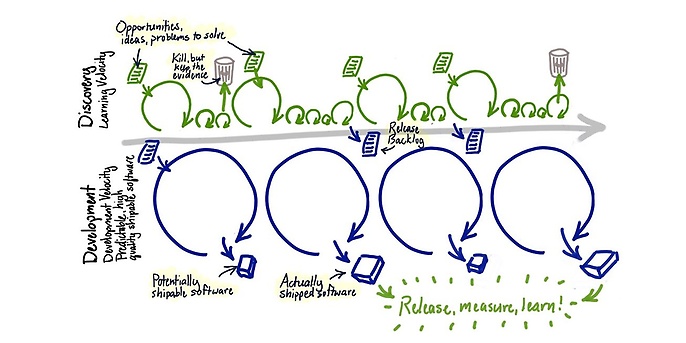30. March 2023 By Lena Wirtz
UX can also be agile with the dual-track agile framework
Agility means thinking in terms of minimal viable products or increments for the majority of organisations. However, in our role as user experience (UX) specialists, we work on a holistic user experience and design the big picture of a product. On the one hand, as UX experts, we are part of the team, because a common product vision is pursued in the team. On the other hand, however, we do not feel that we are a part of it, as the development of a requirement takes place far ahead of the implementation of the same requirement. At any given time, we could be working as a team on different areas of the product. This is where two worlds meet that are often difficult to reconcile.
One solution to this problem is the dual-track agile framework, which emerged from UX expert Desirée Sy’s need to adapt her UX activities to the different velocities of the rest of the team. She herself had not defined a name for this framework, but ‘dual-track agile’ has become established over time.
Timeline
The Agile Manifesto was published in 2001 and many companies adopted it, converting their product development from conventional to agile. The UX specialists, who were mostly concerned with a holistic UX and the big picture, were taken aback by the fact that small increments and MVPs were now to be developed and designed. Desirée Sy felt no different. Sy, however, dared to make a change in 2007. She accepted the challenge and jumped on the agile bandwagon. Her vision was to carry out user-centred design practices within an agile framework. She wanted to unite the processes from the development of a product idea to its implementation in one process. This included adjusting the duration and granularity of UX activities. Ten years later, Jeff Patton elaborated on her idea. I will present the structure of the dual-track agile framework according to Jeff Patton in the following.
Structure of the framework
Dual-track agile is a methodology that contains two separate tracks. They are mapped out and worked through in parallel. In Patton’s model, both tracks are worked through in cycles of different lengths. The different sizes of the circles in the figure depict this. The discovery track is visualised in the upper part of the figure and the development track, also called the delivery track, in the lower part. According to Patton, these two tasks should be dealt with in different tracks, as they are two different types of work and also require two different types of thinking. However, both are equally necessary parts of product development and should therefore both be carried out using the same lean and agile methods so that, according to Patton, they run within the same process. What does this mean for the activities in the two tracks?

Dual-Track Agile nach Jeff Patton (jeffpattonassociates.com/dual-track-development/, 2017)
Discovery track
The discovery track aims to generate potential solutions from ideas, problems and customer/user requests and to validate them directly in the same cycle. A rapid gain in knowledge is pursued through validation, denoted as ‘learning velocity’ in the figure. After one cycle, each potential solution is explored and a decision is made as to whether it should be pursued in the development track or discarded. Both paths lead to new insights in the team, regardless of what is decided regarding the solution. The selection of the hypothesis to be worked on next is determined by the properties of high risk and high uncertainty. As viewed in the figure, discovery is not only carried out in stages for new releases, but takes place continuously within cycles of varying lengths. Patton does not work in cycles of equal length in the discovery track in order to keep the conception and validation of different ideas as short as possible and to quickly come to a decision: build it, kill it or keep learning. Patton takes a lean approach here and tries not to waste resources. An idea that does not lead to a potential solution for the product should be discontinued as soon as this fact becomes clear. However, ideas that lead to solutions should be further elaborated and transferred to the development track, where they are implemented at best one to two sprints later. As can be seen, the generation of product ideas and solutions is also upstream here in dual-track agile, but here we are talking about a few days or weeks and these ideas have already been validated before implementation.
Development track
The development track is about implementing the product ideas that were generated and validated in the discovery track. The output of this track is a potentially shippable/releasable product increment. This track results in cycles of equal lengths and plannable since the idea has already been worked out as an adequate solution for the product. To be clear, the focus of this track is on plannability and quality. Patton’s motto is ‘release, measure, learn!’ as a means to improve these two traits.
Dual track does not mean dual team
Even though they are two separate tracks, a cross-functional team will work together toward the common product goal. Each team member works in both tracks, even if their expertise and area of work tends towards one track. However, the other track is actively supported with knowledge. In the discovery track, the developers input their knowledge and analyse, for example, the technical feasibility of the ideas. In the development track, the UX specialists provide their input by answering questions from the developers about the design or user need of the ideas during the sprint.
Challenges from experience
We encountered the following challenges during the implementation of a customer project when applying this framework:
- Sharing UX activities on cycle length
- Estimating UX activities
- Risk of unintentional splitting of the team into discovery and development team
- Allocation of resources of the team members to the tracks
- Transparency in the team across both tracks
Conclusion
In summary, this framework has the potential for a high learning curve for the team due to the short cycles when it comes to generating ideas and it can lead to a rapid maximisation of value for the user. In addition, the collaboration of the whole team is promoted through the joint process. However, you need to keep in mind that this framework also needs an adequate introduction in order to overcome the challenges mentioned.
We might follow up with a post on the use of dual-track in Scrum or Kanban based on the basics presented here.
You will find more exciting topics from the adesso world in our latest blog posts.

